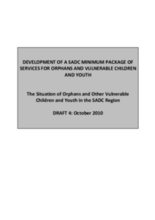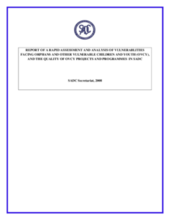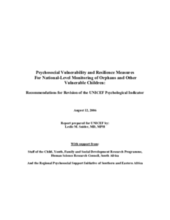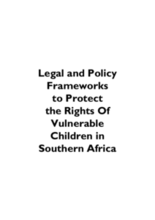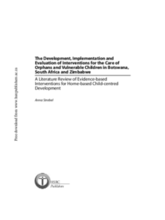Displaying 21 - 28 of 28
This Situation Analysis Report is one of a series of three documents: (1) Report on the Situation of Orphans and Vulnerable and Children and Youth in the SADC Region; (2) Conceptual Framework for Psychosocial Support for Orphans and Vulnerable Children and Youth in the SADC Region; and (3) Minimum Package of Services for Orphans and Vulnerable Children and Youth in the SADC Region. The Situation Analysis Report has informed the development of the PSS Framework and the Minimum Package of Services.
As a result of the HIV/AIDS pandemic, there are now more than 12 million orphans in sub-Saharan Africa. The majority of these children have been absorbed into their extended families.
This study uses recent data from published studies in sub-Saharan Africa to illustrate deficits and document community responses for children who have lost parents to the HIV/AIDS pandemic.
This study sought to assess, analyse and inform the different forms of vulnerabilities affecting children and youth, and their effects and existing strategies and programmes addressing the challenges and vulnerabilities facing orphans, vulnerable children and youth (OVCY) in the Southern Africa Development Community (SADC) region. The study also sought to propose recommendations for improvement, and development of minimum standards for OVCY and the finalisation of the SADC OVCY Strategic Framework.
This document discusses the work contributing to the area of psychosocial measurement with regard to HIV/AIDS and provides samples of surveys that can be used in measurement.
Reviews legal and policy frameworks for the protection of OVC rights in 10 Southern African countries. Includes key concerns and recommendations. Appendix includes country-specific details of National Policies on Orphans and Vulnerable Children and National Plans of Action.
Discusses the interplay between informal and formal safety net mechanisms in supporting orphans and children made vulnerable by HIV/AIDS. Includes recommendations for strengthening traditional family and community safety nets weakened by the epidemic.
A review of interventions for orphaned and vulnerable children that focuses on community-supported, home-based care examples. Highlights several models and programs, such as the COPE approach and Village AIDS Committees. Advocates the need for more research-based interventions and evaluation.

